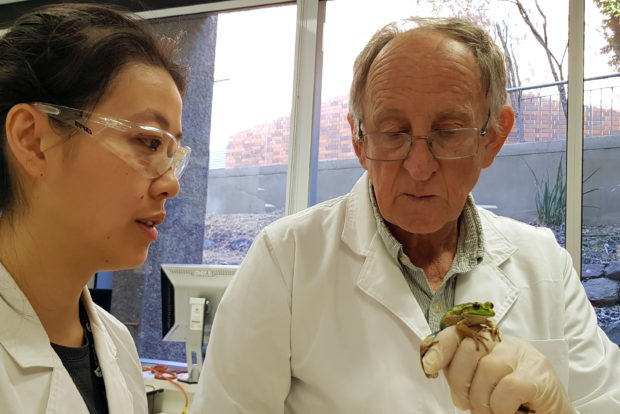Frog whisperer: Australian scientist speaks to frogs, fears their silence

Professor Michael Mahony holds a Green and Golden Bell Frog as PhD candidate and research assistant Rebecca Sceto looks on inside a laboratory at the University of Newcastle, Australia, June 4, 2021. REUTERS
SYDNEY — Wading through a moonlit pond on Australia’s east coast talking to frogs makes Michael Mahony feel like a kid again.
The 70-year-old biology professor and conservationist at Australia’s University of Newcastle has mastered imitating and understanding the shrills, croaks and whistles of frogs.
“Sometimes you forget to work because, you know, you just want to talk to the frogs for a while and it’s sort of good fun,” Mahony told Reuters from a pond in Cooranbong, New South Wales.
He is thrilled every time they call back, but fears frogs are increasingly at risk of going silent.
Australia has about 240 frog species, but around 30% of them are threatened by climate change, water pollution, habitat loss, the chytrid fungus, and in a variety of other ways. Globally frogs are the most threatened of all vertebrates, Mahony said.
Article continues after this advertisementOver his career, Mahony has described 15 new species of frogs. He has also seen some wiped out.
Article continues after this advertisement“Probably the saddest part of my career is that as a young person, I discovered a frog and within two years of it being discovered that frog went extinct,” Mahony said.
“So very early in my career I became aware just how vulnerable some of our frogs were. We need to be looking at our habitats and asking what is wrong.”
Beyond working to preserve amphibian habitats across Australia, Mahony has helped to develop a cryopreservation method to help bring frogs back from the edge of extinction by “banking” genetic material.
“What we’ve done in the face of the problems of catastrophic loss of species is to establish the first genome bank for Australian frogs,” he said.
Mahony also contributed with other scientists to a study by the World Wide Fund for Nature (WWF) that found nearly three billion Australian animals were killed or displaced by bushfires in 2019 and 2020, including 51 million frogs.
Mahony’s passion for conservation has also rubbed off on his students. One of them, Simon Clulow, named a newly discovered frog “Mahony’s Toadlet” in his honour in 2016.
Some students have taken up his technique of calling and talking to frogs as well.
“I’ve never been into yelling at them to find out where they are,” University of Newcastle doctoral student and frog researcher Samantha Wallace said.
“But it definitely does work, so it does pay back, especially when you’re trying to find some of these species that are really amongst the undergrowth and they’re not really obvious.”